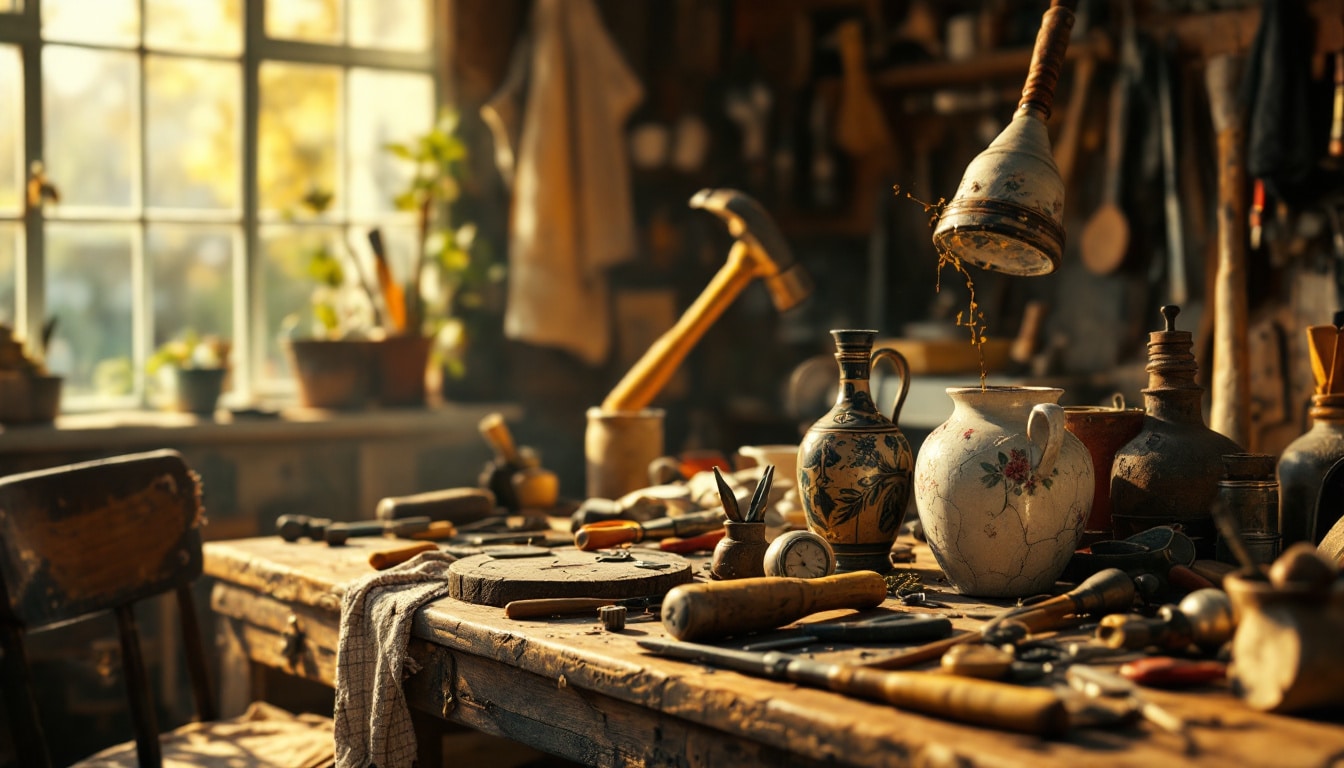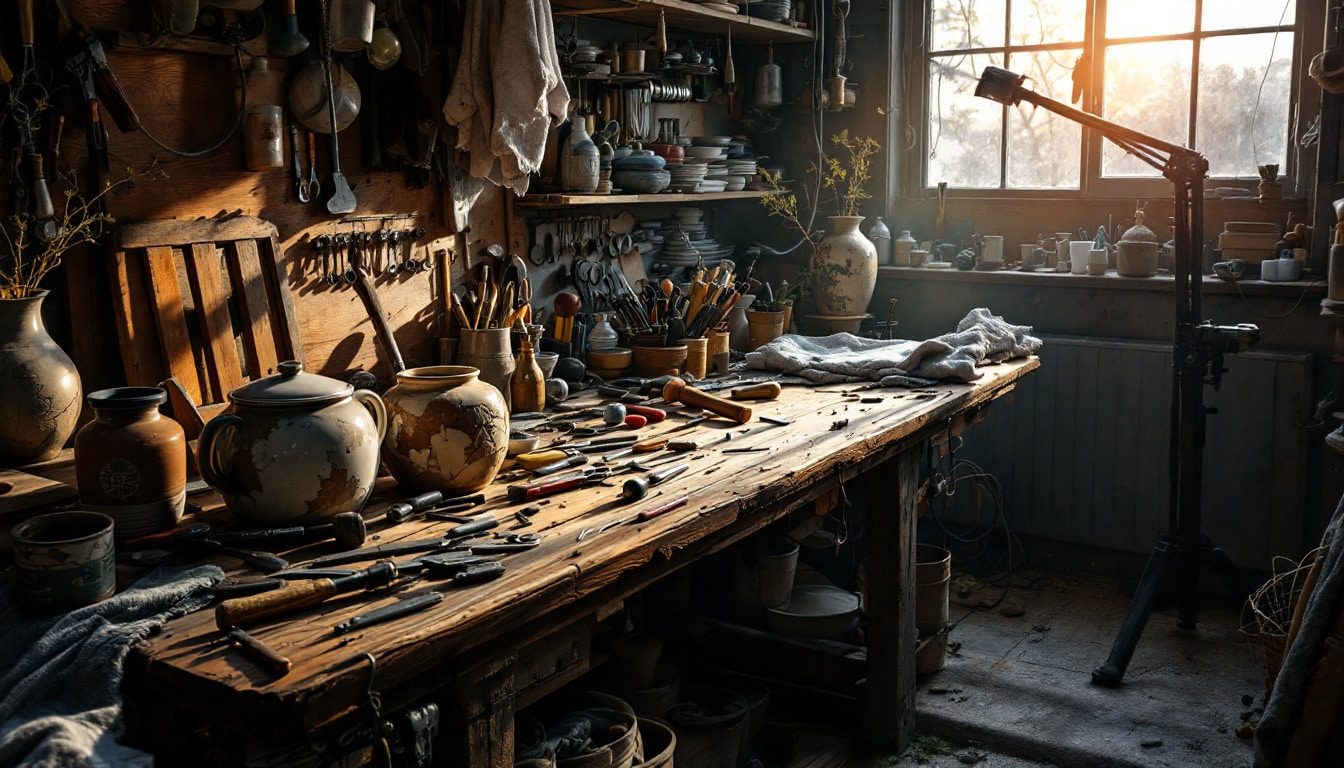Repair is emerging as an innovative response to overconsumption and waste. More and more people are choosing to repair rather than throw away, thereby combining economy with environmental protection. This practice also fuels their creativity and strengthens community bonds.
At Westbeth, a community of artists residing in Manhattan, this trend makes perfect sense. John Murphy, meticulously repairing a Leda brand lamp, perfectly exemplifies this commitment. Alongside Junko Barrow, they transform broken objects into unique and functional pieces. Not far away, Dennis Fitzpatrick enjoys restoring an ornate chair found on the street, demonstrating “reverse creativity”. Paula Newman, another resident of West Village, recently remade a beautiful garment for the granddaughter of a volunteer present at the registration desk. A repairer is also busy bringing a damaged printer back to life. These initiatives are part of the Noche de Reparación, a collaboration organized by Fixers Collective. This event, held five times a year, has become a real meeting point for repair enthusiasts in the neighborhood.
Carole Braden, chair of the conservation of the Westbeth Artist Residents Council and coordinator of Fix-It Night, explains: “This brings people together to help each other and prevents objects from ending up in the trash.” She adds that the goal is to train participants to make their own repairs by sharing skills and tools. Braden also emphasizes the social aspect of these meetups, where repair becomes a meaningful community act.
The repair movement is not limited to Westbeth. In the Hudson Valley, New York, the Repair Café organized by Suzie Fromer is experiencing great success. With 70 cafes spread across villages such as New Paltz, Rhinebeck, and Walkill, hundreds of volunteers, primarily elderly people, offer their expertise. These events, providing tea, coffee, and baked goods, resemble a true village square, fostering exchanges and sharing.
The benefits of repair are numerous. Aside from the environmental pretext, consumers realize significant savings by prolonging the lifespan of their items. Wayne Seltzer, a retired electrical engineer and founder of the Boulder U-Fix-It Clinic in Boulder, Colorado, highlights that “many products were designed to be easily repairable, with accessible parts and service manuals. Today, items are often more complex, making their repair difficult, if not impossible.”
What are the most repaired objects? Lamps, in particular, are very popular. “People are very attached to their lamps, and electrical issues can be daunting. Repairing lamps is a gateway to other repairs,” Seltzer explains. Repair workshops, like the one in Boulder, reuse recycled cables and distribute LED bulbs for a sustainable solution. Clothing repair, with hems or patches, is also common, as is the refurbishment of small home appliances and electronic devices.
The creative side of repair is often highlighted. Fromer, a jewelry maker by profession, repairs earrings, necklaces, and bracelets, stating: “It’s extremely creative to quickly repair things with what you have on hand. Repair cafés are like triage emergency rooms. I’ve seen people cry with joy when reclaiming their broken jewelry.” Sometimes, innovative solutions emerge, like using a 3D printer to create replacement parts, thus enabling others to benefit from these innovations.
The movement is also supported by legislative initiatives. All 50 U.S. states now have laws related to the right to repair, aimed at requiring manufacturers to provide the necessary parts and manuals. Organizations like iFixit offer thousands of free guides and tutorials online, making repair accessible to all. Activists in the movement continue to revive interest in repair, thereby contributing to a more sustainable future, one lamp at a time.
And you, what have you managed to save from the trash thanks to your creativity? Share your experience in the comments!

Table des matières
ToggleWhy repair rather than throw away?
In a society where frenzied consumption is the norm, repairing rather than throwing away takes on crucial importance. Every year, millions of items end up in landfills, contributing to pollution and the depletion of natural resources. By choosing to repair, not only do you save money, but you also protect the environment. Furthermore, repair stimulates your creativity and strengthens practical skills.
More and more people are adopting this eco-friendly and economical approach. For instance, during the Repair Night at Westbeth Artists Housing in Manhattan, residents and volunteers collaborate to revive items like lamps, chairs, and clothing. This local initiative fits into the global movement of Repair Cafés, which encourage community repair and sustainability.
How do Repair Cafés contribute to the community?
Repair Cafés play an essential role in strengthening community ties. They provide a space where individuals can meet, share knowledge, and collaborate on repair projects. At Westbeth, for example, experienced volunteers like John Murphy and Dennis Fitzpatrick share their skills with other residents, thus fostering a sense of belonging and solidarity.
These events are not limited to simply repairing objects. They also provide opportunities for mutual learning and knowledge transfer. Carole Braden, chair of the conservation of the Westbeth Artist Residents Council, emphasizes that these meetups allow participants to develop new skills while preventing valuable items from ending up in landfills. Furthermore, Repair Cafés help create a sustainable community where mutual aid and creativity are at the heart of interactions.
To learn more about similar initiatives, visit this link that showcases new fiscal initiatives supporting local eco-friendly movements.
What objects are most commonly repaired?
The variety of objects that can be repaired is astonishing, ranging from electronic devices to clothing, including toys and furniture. At Westbeth Fix-It Night, branded lamps, ornate chairs, and even printers frequently fall under repairs. Lamps, for instance, are particularly popular as they are often sentimental items and their repair can be relatively simple, making them accessible to beginners.
Textiles, such as clothing and accessories, are also highly sought after. Paula Newman, a regular at Repair Cafés, recently repaired a lovely dress for the granddaughter of a volunteer. These repairs not only improve the appearance of items but also extend their lifespan, thereby reducing the need for new purchases. Moreover, tech gadgets such as printers or microwaves are often repaired, although some, like microwaves, present specific technical challenges.
For a more comprehensive list of repairable items and innovative solutions, check this article that explores local solutions to economic challenges.
What are the economic and environmental benefits of repair?
Choosing to repair offers significant economic benefits. By repairing an item instead of replacing it, consumers can achieve substantial savings. This is particularly relevant in the current economic context where many people are looking to reduce their expenditures. Wayne Seltzer, an electrical engineer and founder of the Boulder U-Fix-It Clinic, emphasizes that free repairs offered in local clinics have allowed more than 2,000 participants to benefit from these services since 2013.
From an environmental perspective, repair helps reduce waste and resource consumption. By extending the lifespan of objects, we decrease the demand for new productions, which reduces the carbon footprint and pressure on natural resources. Furthermore, Repair Cafés promote recycling and reuse of materials, thus contributing to a more sustainable circular economy.
Moreover, these initiatives also support local jobs and encourage the development of technical skills within the community. This creates a virtuous circle where the local economy is strengthened while respecting the environment.
How do local initiatives, like those in Westbeth, inspire global change?
Local initiatives such as the Repair Night at Westbeth serve as inspiring models for other communities around the world. By combining community efforts with sustainable practices, these events demonstrate how simple actions can have a significant impact. Westbeth has created a meeting point for repairs, transforming a simple evening into a rewarding collective experience.
These local initiatives also contribute to the international movement of Repair Cafés, which began in Amsterdam 15 years ago and is now present in many countries. By adapting to local specifics, as New York does with its artistic communities at Westbeth, these Repair Cafés promote personalized and effective solutions. For example, the Repair Cafés of Hudson Valley not only offer repair services but also a cozy space where locals can share moments over tea or coffee, thereby strengthening the social fabric.
To discover how other local initiatives influence the global movement, check out this article that highlights inspiring stories of resilience and passion.
What are the current challenges of modern repair?
Despite the many benefits of repair, the movement faces several challenges. One of the main obstacles is the increasing complexity of modern products, which makes repair more difficult or even impossible in some cases. Technological objects, such as smartphones and electronic devices, are often designed with non-modular parts and without access to service manuals, thus limiting the repair capabilities of community workshops.
An additional challenge lies in the lack of awareness and training. Many people do not know how to repair their objects or are unaware of the available resources. Initiatives like those in Westbeth play a crucial role by offering training and providing equipped spaces to encourage DIY (Do It Yourself).
Furthermore, legislation can also hinder the movement. Although all 50 U.S. states have adopted or are in the process of adopting laws regarding the right to repair, the implementation and expansion of these laws remain a work in progress. Support from organizations like iFixit is essential to advocate for laws that require manufacturers to publish the parts and manuals necessary for repair. To stay informed about legislative developments, check out this article addressing the latest fiscal initiatives.
Interactive Conclusion
Repair goes far beyond merely restoring an object; it embodies a philosophy of sustainability and community solidarity. By participating in Repair Cafés or learning to repair on your own, you contribute to a more environmentally friendly future and strengthen the bonds within your community. Your personal experience matters too!
Your turn: What have you saved from the landfill thanks to your creativity? Share your experience in the comments!








